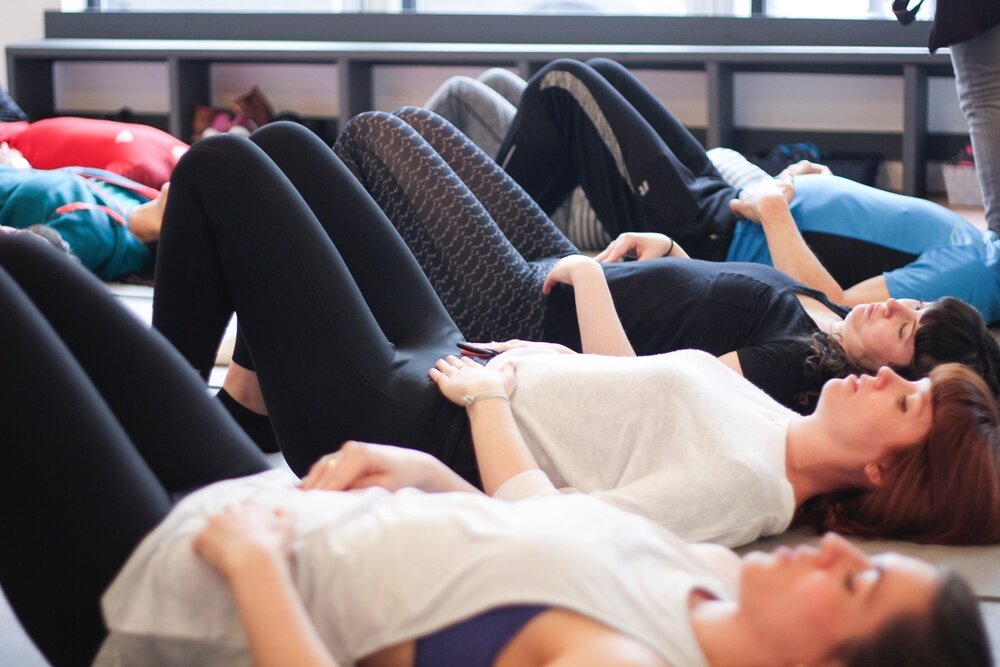Bad Back? Maybe it's the way you breathe.
Right now, as you are reading this article, pay attention to your breathing. Are you breathing more in your abdomen or more in your chest? If you are unsure, place one hand on your stomach and the other hand on your chest. Which hand is moving more? If you are breathing more in your chest, you have a predisposing movement dysfunction that is likely related to your symptoms!
Aside from getting oxygen, your breath has other important functions. It also plays the role of creating stability in your core and spine.
Intra abdominal pressure (IAP) is one of my absolute favorite things to train, and it’s applications are limitless. Rooted in Dynamic Neuromuscular Stabilization, IAP is the core (pun intended) of every movement pattern we have as humans. Simply put, IAP is the proper utilization of the breath and the diaphragm to create 360 degrees of pressure throughout the abdomen, allowing authentic contraction of the abdominal and pelvic muscles to create support for the spine and extremeties.
Intra Abdominal Pressure (IAP)
IAP is a developmentally ingrained ability that we have as humans. Imagine a baby, with their large belly hanging out as they learn to reach, roll, crawl, or sit up- this is intra abdominal pressure! Though we all learn how to move through using IAP as we develop, many adults are no longer utilize this instinctive stabilization strategy. There are two major reasons that adults don’t use IAP:
1.) Pain and Injuries
Our bodies have unique ways of creating compensations for physical and emotional trauma. Unfortunately, one of them is an alteration in how we stabilize our core. Often, in these cases, the automatic ability of creating IAP becomes absent, delayed, or lost during movement.
2) Cosmetic, Cultural or Learned Behavior:
More often than not, people learn to “suck in” their stomach in an attempt to look thinner. Other people, especially common in yogis, are taught to “suck in” or “pull in” their stomach as an exercise to activate their core. Even though some abdominal muscles are contracting when they pull their belly button towards their spine, they are contracting their muscles in the exact opposite direction that is needed to create IAP and increase spine stability. If this “pulling in” strategy becomes habit, it will have a destabilizing effect on the spine which will eventually lead to pain and wear and tear on spinal tissues. (Yogis, please let’s start a discussion about normal breathing patterns vs mula bandha! There is a time and place for deviations from ‘normal’ breathing patterns, BUT FIRST, normal must be established! More on this later!)
So what next?
Thankfully, IAP is something that most adults can relearn relatively quickly. The best thing to do is find a DNS provider who can help guide you in learning how to create IAP and maintain it through the movement patterns you use every day. Many people have trouble knowing for sure if they are creating IAP and maintaining it properly, but there are a few good exercises you can start implementing today.
How to Assess Your Ability to Create IAP
Place your hands around your waist, with your thumbs in the small of your back, and fingers draped around the sides and front of your belly. Push out into your hands, and tighten up/flex your abdominal muscles at the same time. Think about tightening up your abdominals as if someone is going to punch you in the stomach. If you do it correctly, you should feel pressure build inside your abdomen (IAP) and all parts of your abdominal wall move outward and tighten up. If you are unsure, cough a few times and that is the feel you are looking for. You should feel symmetrical outward excursion and tightening of your entire abdominal wall, especially in your back where your thumbs are located, in the front where your fingertips are, and in the lowest part of your abdomen below your belt line just above your groin.
If you find an area that is not pushing out or tightening up very well, these are the areas that you need to work on. You can make this an exercise by placing your hands in your weakest areas and pushing out and tightening up. Hold for a second, release, and repeat 10-20 times or until fatigue. You can do this multiple times a day, every day. A fun rule I tell my patients to live by is to practice your IAP every time you’re stopped at a red light or a tv commercial comes on. Additionally, it is important to practice this in all positions…lying on your back, stomach, each side, sitting, and standing.
Breathing also plays the role of creating stability through your core and spine.
As you get better at creating IAP, you should also be able to breathe into your abdomen (diaphragmatic breathing) at the same time you have created IAP. Here’s the test: Create IAP by pushing out and tightening up no more half way (less than 50% effort). Now, breathe into your abdomen while you keep the pressure constant, especially on the exhale. This is very difficult for most people to do and represents a further predisposing risk factor for back pain.
Want to learn more?
Find out more information on intraabdominal pressure and dynamic neuromuscular stabilization at www.rehabps.com. Feel free to send me a message if you’d like to visit me for a breathing assessment and DNS based rehab OR let me help connect you with a DNS provider near you.
Dr. Hannah is certified in DNS Exercise 1, Yoga Specific Level 1, and Yoga Specific Level 2.






